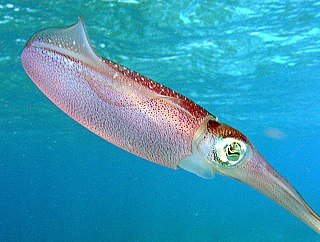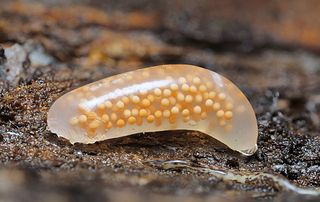
Nemertea is a phylum of animals also known as ribbon worms or proboscis worms, consisting of 1300 known species. Most ribbon worms are very slim, usually only a few millimeters wide, although a few have relatively short but wide bodies. Many have patterns of yellow, orange, red and green coloration. The foregut, stomach and intestine run a little below the midline of the body, the anus is at the tip of the tail, and the mouth is under the front. A little above the gut is the rhynchocoel, a cavity which mostly runs above the midline and ends a little short of the rear of the body. All species have a proboscis which lies in the rhynchocoel when inactive but everts to emerge just above the mouth to capture the animal's prey with venom. A highly extensible muscle in the back of the rhynchocoel pulls the proboscis in when an attack ends. A few species with stubby bodies filter feed and have suckers at the front and back ends, with which they attach to a host.

Lophotrochozoa is a clade of protostome animals within the Spiralia. The taxon was established as a monophyletic group based on molecular evidence. The clade includes animals like annelids, molluscs, bryozoans, brachiopods, and platyhelminthes.

Anopla has long been used as name for a class of marine worms of the phylum Nemertea, characterized by the absence of stylets on the proboscis, the mouth being below or behind the brain, and by having separate openings for the mouth and proboscis. The other long used class of Nemertea are the Enopla. Although Anopla is a paraphyletic grouping, it is used in almost all scientific classifications. Anopla is divided into two orders: Palaeonemertea and Heteronemertea.

Palaeonemertea is a class of primitive nemertean worm. It may be para- or polyphyletic, consisting of three to five clades and totalling about 100 species.
Rhabdites are rodlike structures in the cells of the epidermis or underlying parenchyma in certain turbellarians, and in the epidermis of nemerteans. They are discharged in mucous secretions. They are a defensive mechanism, which dissolve in water, and they are distasteful to most animals who would prey on rhabditid worms. In nemerteans, rhabdites form mucus on which the animals glide.

Enopla is one of the classes of the worm phylum Nemertea, characterized by the presence of a peculiar armature of spines or plates in the proboscis.
The Percy Sladen Trust Expeditions to the Abrolhos Islands were two scientific expeditions, conducted in 1913 and 1915 under the leadership of Professor William John Dakin and funded by the Percy Sladen Trust. These expeditions conducted extensive research into the natural history of the Houtman Abrolhos, an archipelago in the Indian Ocean off the coast of Western Australia.

Parborlasia corrugatus is a proboscis worm in the family Cerebratulidae. This species of proboscis or ribbon worm can grow to 2 metres in length, and lives in marine environments down to 3,590 metres (11,780 ft). This scavenger and predator is widely distributed in cold southern oceans.
Prostoma jenningsi is a species of ribbon worm known only from one site near Croston, Lancashire. It was described in 1971, and is believed to be the county's only endemic species. It grows up to 20 mm (0.8 in) long, with 4–6 black eyespots, and has a long eversible proboscis.
Gononemertes australiensis is a parasitic ribbon worm. It lives commensally in the ascidian Pyura pachydermatina found in the sublittoral waters of the New Zealand. G. australiensis was found in specimens of P. pachydermatina collected in Sydney harbor. These worms were found specifically in the atrium of P. pachydermatina. It is dioecious and has several gonads. Each of its gonads produce several oocytes while the male worms carry testes along its parenchyma. Fertilization is external.

Arthur Dendy was an English zoologist known for his work on marine sponges and the terrestrial invertebrates of Victoria, Australia, notably including the "living fossil" Peripatus. He was in turn professor of zoology in New Zealand, in South Africa and finally at King's College London. He was a Fellow of the Royal Society.

Malacobdellidae is a monogeneric family within the phylum Nemertea. It is included with the order Hoplonemertea within the class Enopla.

Argonemertes is a genus of nemertean worms belonging to the family Prosorhochmidae. It may be transferred to the family Plectonemertidae. It contains the following species:
Argonemertes hillii is a species of nemertean worms in the family Prosorhochmidae that is endemic to Australia, and is found east of the Great Dividing Range in northern New South Wales and southern Queensland. It inhabits in damp woodlands, dry sclerophyll forests and tropical and subtropical rainforests, and is usually found under logs.
Dr Andrew Rodger Waterston OBE FRSE FRES was a Scottish zoologist, specialising in malacology and entomology. He was interested in the insect fauna of the Middle East and in the fauna of the Outer Hebrides. He was generally known as Rodger Waterston.

Tubulanus polymorphus is a species of ribbon worm in the phylum Nemertea. It is found in the northern Atlantic Ocean and the northern Pacific Ocean. It occurs on the lower shore down to about 50 m (160 ft), on sand or gravel, under stones and among seaweed.

Tubulanus annulatus, commonly known as the football jersey worm, is a species of ribbon worm in the phylum Nemertea. It ranges across the northern Atlantic Ocean, the North Sea and the Mediterranean Sea, being present from the lower shore down to about 40 m (130 ft), on sand, gravel and other habitats.

Gorgonorhynchus repens is a species of the proboscis worm in the subclass Heteronemertea and of the family Gorgonorhynchidae. It is to be found on the seabed in shallow water in the Pacific Ocean.
Carcinonemertes errans is a ribbon worm in the family Carcinonemertidae. It lives in symbiosis with the Dungeness crab, consuming the crab's developing eggs. In 1980 it was implicated in the collapse of the Dungeness crab fishery in central California.

Geonemertes pelaensis is a species of terrestrial Nemertea. Superficially, Geonemertes pelaensis resembles a land flatworm and lives in the same habitat, but it has an anterior exertile proboscis, whether flatworms have a pharynx located in their ventral side at midlength of body. The number of eyes this nemertean can have varies between 4 and 8 ocelli.













